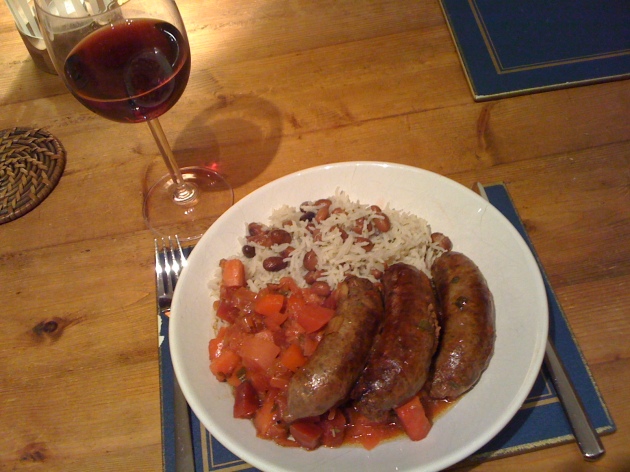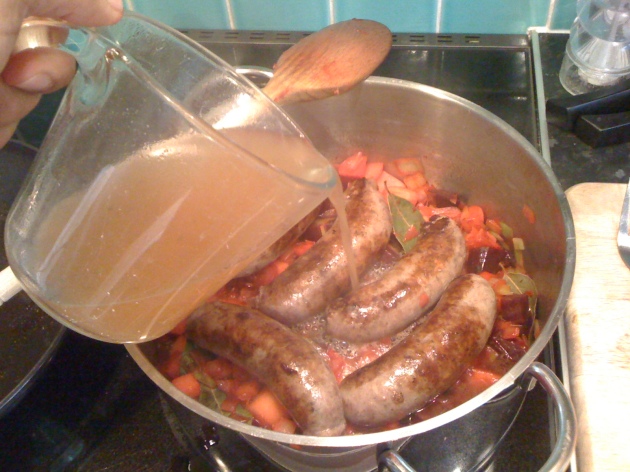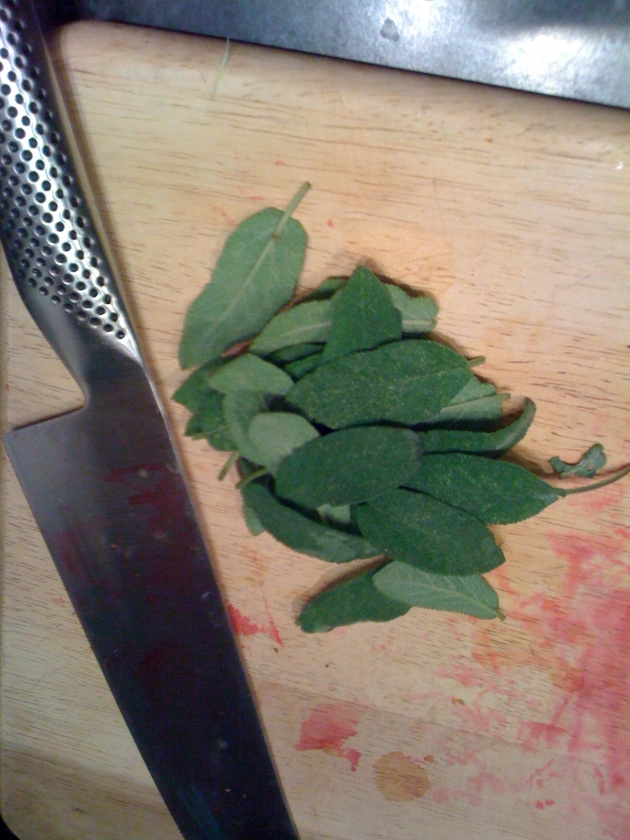
Roasted perch and tomatoes served with bread
I do like to read.
So when the opportunity came up to visit my parents, brother, sister, brother in law and niece and nephew at a nice villa in the South of France (Languedoc) the other week I jumped at the chance.
The idea was that while not contributing to the holiday per se, I would cook for everyone, thus saving money overall on the inevitable meals out and takeaways which would have otherwise drained the financial resources.
The problem with reading for me is that, doing what I do, there are really no set hours for work and relaxation as such.
This last year and a half or so, I seem to have been touring rather a lot (Us3, Jim Mullen, Marlena Shaw, Mica Paris, Boy George – each different band presents a different dynamic as to convenient reading opportunities) and although, as you can imagine, there is sometimes a lot of sitting around, I tend not to get through too many books on the road, the main inhibiting factors being (not necessarily in this order):
- Alcohol – although a couple of drinks sometimes enhance my enjoyment of a book, one too many and I can’t remember what I’ve read when sobered up.
- Travel – I can’t read in a car or a minibus, and although it is possible to read on the tourbus, there’s too often distracting activity like DVD watching, animated conversation or the aforementioned alcohol in commencement at any one time.
- Noise – A lot of sitting around can occur in soundchecks, but have you ever tried to read with a bass drum or tom tom being played repetitively at high volume through a large PA for the purposes of equalization?
- Cabin fever – I tend to find it difficult to read for prolonged periods when confined to a small space like a hotel room.
- Unsettlement – At airports waiting for the gate number to appear, one is always looking up at the screen in the waiting lounge, thus providing an unwelcome break in concentration.
- Unsocial flight times – A fair amount of flights that we take are often very early in the morning, so while reading on the plane is an option, I’m more likely to want to sleep if possible.
And when at home I equate reading with not doing something constructive (not quite true I know), so I’m much more likely to get to work in the studio or at the piano.
I can get really into reading first thing in the morning (a couple of years ago I got through quite a few Iris Murdoch books just this way), but it does tend blunt my concentration for a couple of hours afterwards, as well as taking up half the day so I rarely do this anymore.
SO when the opportunity came up to go on the holiday, the first thing I did was get the books I wanted to read. Last year I did the same thing, but took the wrong book (I took Crime and Punishment – and while I enjoyed reading the book as a whole, I remember being aware that it didn’t necessarily equate to my idea of relaxing by the pool with a beer)
I took 3 books with me this time:
- To Kill A Mockingbird – we read this at school I’m sure, but like a lot of things at school, I didn’t invest much attention or effort to it. Reading it again was a much more enjoyable experience.
- The Life of Pi – couldn’t put this down. Very imaginative, humorous, informative, entertaining, and also lots of references to South Indian food – which is always a good thing.
- The Poisonwood Bible – Am halfway through this at the moment. Thoroughly engrossing characterizations and fascinating historical perspective.
I also did a lot of cooking. The ingredients and produce available at even the most humble French supermarkets always has me fascinated and brimming with ideas (however, since most of the people I was cooking for were not nearly as wildly liberal or adventurous in taste as myself, I was unable to realize many of these ideas).
But I endeavored to make some nice grub anyhow.
Here’s what I cooked:

Sausage and cheese frittata
When I arrived on the Sunday, we discovered all the supermarkets were closed, so I had to rustle something up from what was in the villa already, and what we could acquire from a local service station shop. There was a box of 6 eggs in the villa along with some herbs, and olive oil, and not much else. The service station sold packs of luncheon meat style sausage, and some nice looking Cantal Juene cheese, which is a young cow’s milk cheese, firm in texture and fruity in flavour. I sliced and fried the sausage, drained the fat from the pan, put the sausage meat in once again and added the beaten eggs with some herbs and black pepper. My intention was to then add the grated cheese on top and brown under the grill to cook the top of the eggs and cheese. But… we then discovered that the grill would only operate with the oven door closed, and I didn’t want to commit the frying pan to this unrelenting heat, so I heated up the oven, then opened it and let the top of the frittata firm up in the residual heat. Not ideal, but did the job OK…. the result being a slightly guey cheese underside to the omelette, which was not at all unpleasant, though a bit messy to cut up…
The next day, we got to the supermarket and stocked up on supplies.

Chicken casserole cooked in white wine with green peppers, olives and bay
The meal that night was a simple but very tasty rustic chicken casserole cooked in white wine and stock, with sliced green peppers, olives, onions, garlic, bay and herbs. It was served with mash potatoes and steamed green beans:

Chicken casserole served with mash and beans
…and accompanied by bread with oil and balsemic vinegar (a constant companion to food that week):
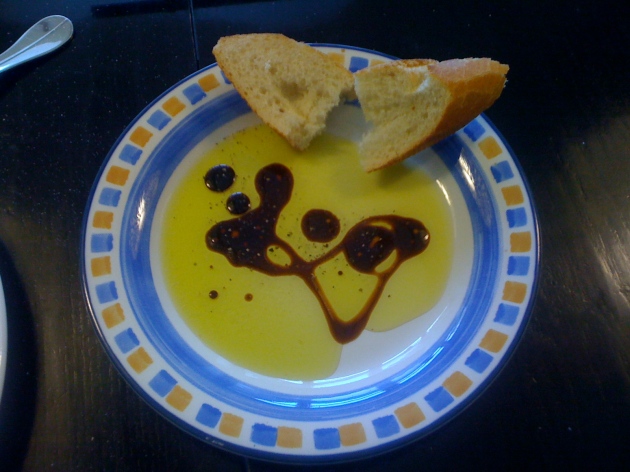
Bread and oil with balsemic
The next morning I made another frittata, this time with sausage and sliced courgettes.
I put the courgettes on the bottom of the pan and the sausages on top, so it appeared like this in the pan:

Sausage and courgette frittata in the pan...
…and took on this lovely appearance when upended onto a plate:

Sausage and courgette frittata
Now before I go any further, I must admit that I did totally steal the idea for an upended courgette frittata from the wonderful blog “Lou Loves Food” … which is packed with amazing photos and absorbing writing, and I can highly recommend it…. so thanks Lou.. 😉
That evening I decided on making some Indian food ….. yes I’m aware that may not be the most obvious option in the South of France, but my mind was made up as soon as I saw the beautiful mutton on offer in the supermarket. Mutton is a meat less than commonly available in the UK, and it rewards slow patient cooking with the most succulent and flavoursome dishes.
I bought some chopped shoulder (on the bone) pieces to make a curry with tomato and aubergine, and some ribs to make what is known as a “Bone Pepperwater”. This is a meat variation on the standard pepperwater (rasam) which is a soup consistency dish made with tomatoes, lemon, tamarind and spices.
The only problem with all this is that I was somewhat limited in the choice of spices available in the supermarket. I managed to get fresh garlic and ginger, and eventually found a premixed curry powder (not something I normally like to use) which seemed to have a good balance of coriander, cumin, tumeric, mustard and fenugreek in it.
The aubergine in the curry was cooked separately with onions, ginger and garlic (a trick I recently picked up off my mother) and added during the last 1/2 hour, which helps to preserve not only it’s texture, but flavour as well. The curry itself simmered slowly for 5 hours.

Mutton curry with aubergine and tomatoes
The bone pepperwater was made with some fresh vegetables (carrots and courgetttes), plenty of lemon and also some paprika, which I found in the villa. The mutton ribs do add the most amazing stocky earthy flavour to this dish, it must be said.
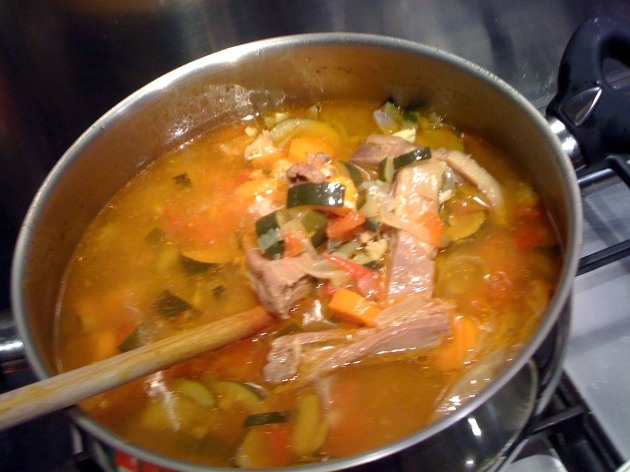
Mutton "Bone Pepperwater"
After the curry, I thought it would be a good idea to cook fish the next day both from a time and simplicity point of view.
The fish counter at the “Intermarche” was of course vastly superior to my local supermarket.
I eventually settled for some lovely fresh perch fillets, which I roasted on a bed of cherry tomatoes with balsamic vinegar, bay and salt.
I gave the tomatoes a start of about 15-20 mins in an 180degC oven, then simply popped the perch fillets on top, cooked for a further 10 mins and it was done:

Perch fillets roasted on a bed of cherry tomatoes with balsamic vinegar and bay..
There was not much need to serve this with anything else but that perennial king of juice mopper-uppers: fresh french bread:

Roasted perch and tomatoes served with bread
The next day was to be barbecue day. However, here I failed in my duty as a blogger and recorder of events since due to the distractions of reading, swimming, table tennis and drinking, I didn’t start the fire in time and so even though I made lots of food, the only picture I managed to take before it went dark was of some balsamic chilli prawns. (I have an iPhone so am unfortunately at the mercy of the light).
Just for the record though, I did also make salmon and courgette kebabs, aubergine and red pepper kebabs, 2 types of sausages and chicken in a Mexican marinade.

Prawns in a balsamic and chilli marinade
One advantage of being in the centre of wine producing country was that there was an abundance of vineyards with completely quaffable red wine on tap at an amazing price. (€1-€1.50 a litre).
Had I the time or opportunity I would have loved to avail myself of some of the delicious looking lambs hearts in the supermarket and braise them in red wine for hours until tender… This meal unfortunately would not have been very popular with the others:
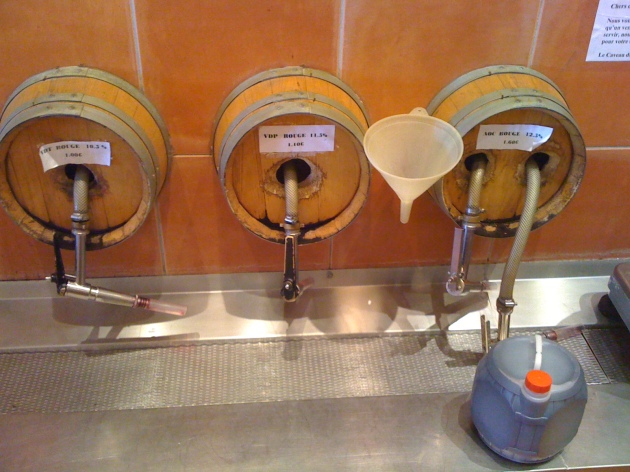
Red wine on tap.....
The final day of cooking was also the least intensive since there was a lot of packing, cleaning of the villa etc to be done before vacating, I opted to cook a simple sausage pasta with a tomato and red wine sauce. Despite appearing fairly ordinary, it was most enjoyable, due to the high quality of the sausagemeat:

Sausage and tomato pasta.....
All in all an enjoyable chance to read, cook, swim and relax…… now, back to the piano I think….
